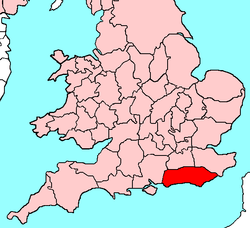| Sussex | |
|---|---|
 | |
 Ancient extent of Sussex | |
| Area | |
| • 1831 | 907,920 acres (3,674 km2)[1] |
| • 1901 | 932,409 acres (3,773 km2)[1] |
| Population | |
| • 1831 | 272,340[1] |
| • 1901 | 602,255[1] |
| Density | |
| • 1831 | 0.3 per acre (74/km2) |
| • 1901 | 0.6 per acre (150/km2) |
| History | |
| • Origin | Kingdom of Sussex |
| • Created | In antiquity |
| • Succeeded by | East Sussex and West Sussex |
| Status | Ceremonial county (until 1974) |
| Chapman code | SSX |
| Government | |
| • HQ | Chichester or Lewes |
| • Motto | We wunt be druv |
Sussex /ˈsʌsɪks/, from the Old English 'Sūþseaxe' ('South Saxons'), is a historic county in South East England.
Evidence from a fossil of Boxgrove Man (Homo heidelbergensis) shows that Sussex has been inhabited for at least 500,000 years. It is thought to be the oldest human fossil ever discovered in Britain.[2]
Near Pulborough, tools have been found that date from around 35,000 years ago and that are thought to be from either the last Neanderthals in northern Europe or pioneer populations of modern humans.[3] On the South Downs lie Neolithic flint mines that date to around 4000BC, some of the earliest in Europe. The county is also rich in remains from the Bronze Age and Iron Age.
Prior to Roman invasions it was occupied by a Belgic tribe called the Atrebates. Togidubnus ruled over much of Sussex when the Roman conquest of Britain began and formed most of the Roman canton of the Regni.
The retreat of Roman forces in the 5th century facilitated the landing of migrants from what is now Germany and created the kingdom of the South Saxons under King Ælle, who is recorded as having held overlordship over other Anglo-Saxon kingdoms and as being the first bretwalda, or 'Britain ruler'. Under St Wilfrid, Sussex became the last of the seven traditional kingdoms of the heptarchy to undergo Christianisation. By the 8th century the kingdom had expanded to include the territory of the Haestingas. Around 827 in the aftermath of the battle of Ellandun, Sussex was annexed by the kingdom of Wessex, a kingdom that with further expansion became the kingdom of England.
In 1066 Norman forces arrived in Sussex, the heartland of King Harold Godwinson. Defeating Harold at the Battle of Hastings, William the Conqueror established five (later six) semi-independent territories known as rapes within Sussex. The South Saxon see was transferred from Selsey Abbey to a new cathedral in the city of Chichester. Castles were built, many the subject of sieges in the High Middle Ages. Sussex was of strategic importance on the most direct route between Angevin lands in England and Normandy. Many Sussex ports, including the Cinque Ports, provided ships for military use.
A succession crisis in the kingdom of France led to the Hundred Years War in which Sussex found itself on the frontline. Various rebellions followed in the late medieval period, including the Peasants’ Revolt, Jack Cade's rebellion and the rebellion of the Merfold brothers.
Under Henry VIII, the church in England split from Roman Catholicism. Mary I returned England to Catholicism and in Sussex 41 Protestants were burned to death. Under Elizabeth intolerance continued on a lesser scale as many Catholics in Sussex died at this time. In Elizabeth's reign, Sussex was open to the older Protestant forms practised in the Weald as well as the newer Protestant forms coming from Continental Europe; combined with a significant Catholic presence, Sussex was in many ways out of step with the rest of southern England.[4] Sussex escaped most of the ravages of the Civil War with two sieges and one battle.

As the Industrial Revolution took hold, the Wealden iron industry collapsed. The growth of the seaside resorts in the 18th century was especially significant in Sussex. Sussex men played a significant role in the first world war Battle of the Boar's Head. At the war's end terms of the Armistice were agreed at Danny House. In World War Two the county was a base for the Dieppe Raid and D-Day landings.
In 1974, the Lord-Lieutenant of Sussex was replaced with one each for East and West Sussex, which became separate ceremonial counties. In the 21st century a county day and a county flag were created for Sussex and a National Park was established for the South Downs.
- ^ a b c d National Statistics - 200 Years of the Census in Sussex
- ^ Neil Oliver (2012). A History of Ancient Britain. United Kingdom: W&N. p. 480. ISBN 978-0753828861.
- ^ McGourty, Christine (23 June 2008). "'Neanderthal tools' found at dig". BBC News.
- ^ Dimmock, Matthew; Quinn, Paul; Hadfield, Andrew (2013). Art, Literature and Religion in Early Modern Sussex. Ashgate Publishing. p. 205. ISBN 978-1472405227.